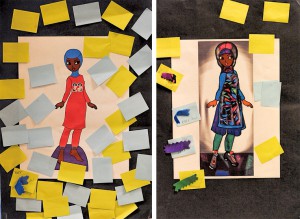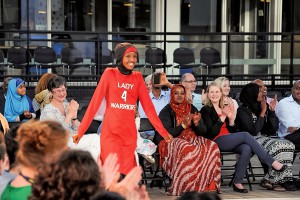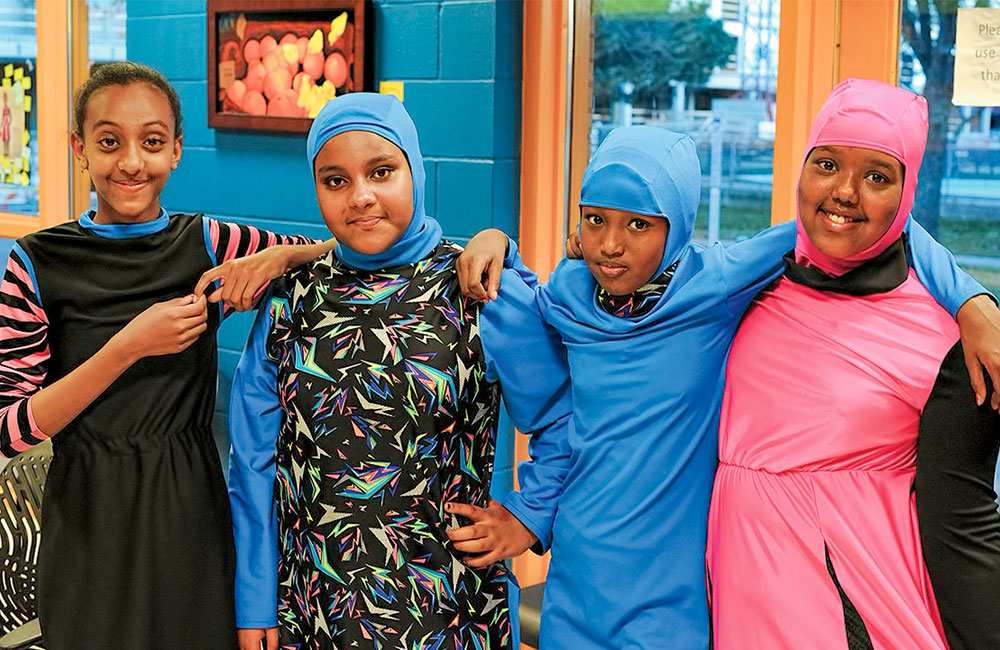Two years of hard work paid off in June as East African middle-schoolers showed off their new activewear at a campus fashion show.
The girls modeled two different designs that take their culture into account: a versatile outfit for general physical activity, and new basketball uniforms—bright red and bearing the team name, Lady Warriors.
Before this, the girls faced challenges playing sports in public because traditional cultural clothing made it difficult to play to their fullest potential. The new activewear, which features breathable leggings, long sleeves, and a tighter “sport hijab,” enables freer movement and allowed some of them to finally become the first traveling basketball team in the community.
Chelsey Thul grinned from the audience as she cheered on the sixth- and seventh-grade girls modeling the specially designed activewear. Thul, lecturer in the School of Kinesiology, became involved in the clothing design as a way to research and address the trend of physical inactivity in diverse populations of adolescent girls.
The project was born in 2013 when Thul collaborated with Elizabeth Bye from the College of Design, Nicole LaVoi from the Tucker Center for Research on Girls & Women in Sport, and Fatimah Hussein, founder of the Girls Initiative in Recreation and Leisurely Sports (GIRLS) in the Cedar–Riverside neighborhood in Minneapolis. GIRLS, a program of GirlsWin nonprofit organization, is an all-female, culturally appropriate physical activity program for Muslim East African girls.
The four set out to form a partnership that would allow the University to conduct valuable research while benefitting the surrounding community.
“Since the first day Chelsey came, she never stopped,” says Hussein, who began working with Thul before the clothing project. “The girls always complained about the many layers, but we didn’t know what to do about it. Then she found the connection to make it happen.”
During the project, Thul and other U collaborators worked closely with the students, coaches, and families involved in the GIRLS program.
“We built relationships together,” says Thul. “It was incredibly important to have a true community-University partnership that lived up to that name.”
Making sure the young students had a say in the process was a top priority. Apparel design professor Elizabeth Bye brought her expertise not just in apparel but in the overall design process. The final clothing design was based directly on drawings the students made while brainstorming with the team. Attendees of the fashion show could see the girls’ sketches displayed near the stage.

“The process was wonderful,” Thul says. “It was a true collaborative effort between the Tucker Center, the College of Design, the GIRLS program, and many community members along the way.”
“The girls’ confidence has changed—it’s changed their lives,” says Hussein. “We all agree that, when we start young, those habits of activity become the norm.”

Much of Thul’s work focuses on implementing physical activity programs for underserved adolescent girls. Creating opportunities is a passion for her. She says getting to know the students and the community over the span of the project made the project all the more meaningful.
“It’s hard to put into words,” says Thul. “Seeing the joy and excitement that the girls have in the design they created and the fact that it’s really going to make a difference in their lives when it comes to sport and physical activity is powerful and exciting.”
Now that the finished clothing can bring opportunities to members of the GIRLS program, Thul and the team want to bring culturally appropriate activewear to even more players and communities.
“The hope is to make these designs accessible for many more girls and women,” says Thul.
Read more at G.I.R.L.S. and “Fashion show displayed culturally appropriate active wear.”
Story by Ellen Fee | Photos by Warren Bruland | Fall 2015
 Four women teamed up with a group of middle-schoolers to create activewear for East African girls.
Four women teamed up with a group of middle-schoolers to create activewear for East African girls.